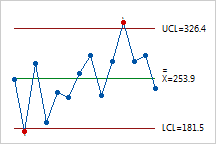Statistical process control (SPC)
The use of statistical techniques to analyze a process in order to monitor,
control, and improve it. The objective is to have a stable, consistent
process that produces the fewest defects possible. Minitab has several
SPC tools, including :
·
Control charts –
track process statistics over time to detect the presence of special causes
variation
·
Capability analysis –
determine
if your process is capable; that is, meeting specification limits and
producing "good" parts
The central idea of SPC is to control variation so as to avoid product
defects. There are two kinds of variation in any process: common causes
and special causes. Common causes refer to occurrences that contribute
to the natural variation in any process. Special causes are unusual occurrences
that are not normally (or intentionally) part of the process. While some
degree of common cause variation will naturally occur in any process,
it's important to identify and attempt to eliminate special causes of
variation.
For example, you work for a company that makes ball bearings, and you
would like reduce the number of defects. Using quality tools such as pareto
charts and cause & effect diagrams you have determined that ball bearing
roughness is your highest defect rate. Before you begin to look for ways
of improving your process, you have to determine whether the process is
stable; that is, whether only common cause variation is present. You test
five samples every hour for two days and then produce an xbar control
chart.
|

|
There are two points that are outside the control limits. You need to
find out why this has happened and eliminate the cause of this variation.
Once you have done this, you can continue to use statistical process control
tools to improve the process and then to monitor the process after improvements
have been made. |
